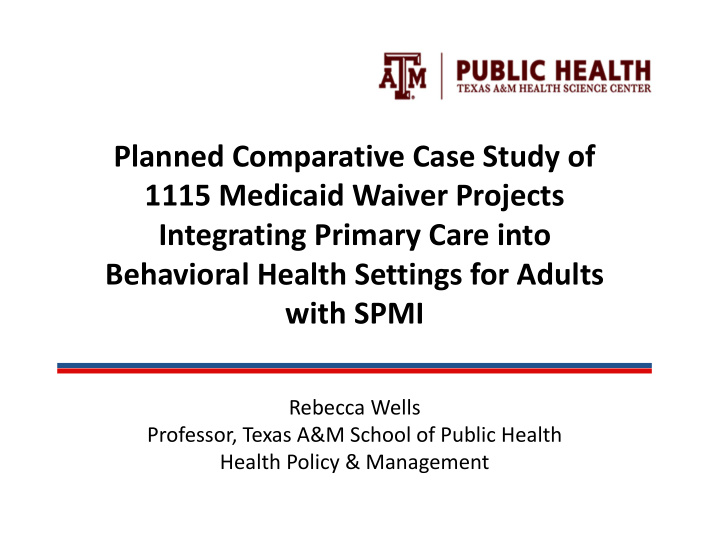



Planned Comparative Case Study of 1115 Medicaid Waiver Projects Integrating Primary Care into Behavioral Health Settings for Adults with SPMI Rebecca Wells Professor, Texas A&M School of Public Health Health Policy & Management
1115 Medicaid Waiver Delivery System Reform Incentive Pool (DSRIP) Projects • ~1,300 projects approved across in Texas • Intended to foster delivery system transformation – Infrastructure Development: 655 projects, totaling $4.0 billion – Program Innovation & Redesign: 680 projects, totaling $3.6 billion – Quality Improvements: 1810 outcomes, totaling $1.7 billion
Current CMS ‐ Mandated Evaluation Includes: • Extent to which, through the implementation of DSRIP projects, RHPs impacted: – the quality of care – the cost of care – the health of the population served • Chose ED ‐ related patient care navigation as common project focus: – revealing system interdependencies – present in all major TX regions
Case Study Theory of Change About How DSRIP Projects May Affect Quality, Cost, and Health Outcomes Implementation Implementation Outcomes Context Effectiveness e.g., provider supply e.g., individual e.g., less ED use engagement
Planned Case Study Focus: Integration of Primary Care into Behavioral Health Care • DSRIP projects that entail: – Focus on adults with SPMI who currently are receiving behavioral health care – Primary care • Intent is to include a range of potentially informative projects • Will not identify sites or individuals
Hypotheses for Planned Study • H1. Primary care use and related outcomes will improve for adults with SPMI involved in DSRIP primary care ‐ behavioral health care integration projects. • H2a. DSRIP primary care ‐ behavioral health care integration projects in more supportive contexts will be more effectively implemented than will projects in less supportive contexts. • H2b. More effectively implemented primary care ‐ behavioral health care integration projects will improve quality, cost, and health outcomes more than will less effectively implemented primary care ‐ behavioral health care integration projects.
Planned Approach • 9 DSRIP ‐ funded projects – 1 in each major TX geographic region except El Paso – Ideally 3 rural, 3 urban, 3 mixed • Fall 2014 site visit to each site – Interviews with project leadership, clinicians, non ‐ clinical staff – Patient/natural support focus groups • Follow up calls with project leadership 2015, 2016 • Encounter/claims data analyses
Examples of Potential Measures • Quality: # primary care visits (claims/encounter data); experiences of individuals served (focus groups) • Cost: primary vs. emergent; total (claims) • Health: potentially preventable emergent health care use (claims/encounter); experiences of individuals served (focus groups)
Planned Deliverables • Fall 2014: Scan of literature for innovative primary care ‐ behavioral health integration • Winter 2015: Descriptive profile of projects • Summer 2017: Initial outcome patterns – Types of projects/implementation and best available indicators of quality, costs (e.g., emergent care), and health outcomes – What can be done? How does it work? What can others learn from these projects?
Follow Up Survey • Seeking your input on context and implications we need to understand • If you have not already signed up for our survey, and/or have any other questions or follow up, please email wells@tamhsc.edu
Recommend
More recommend